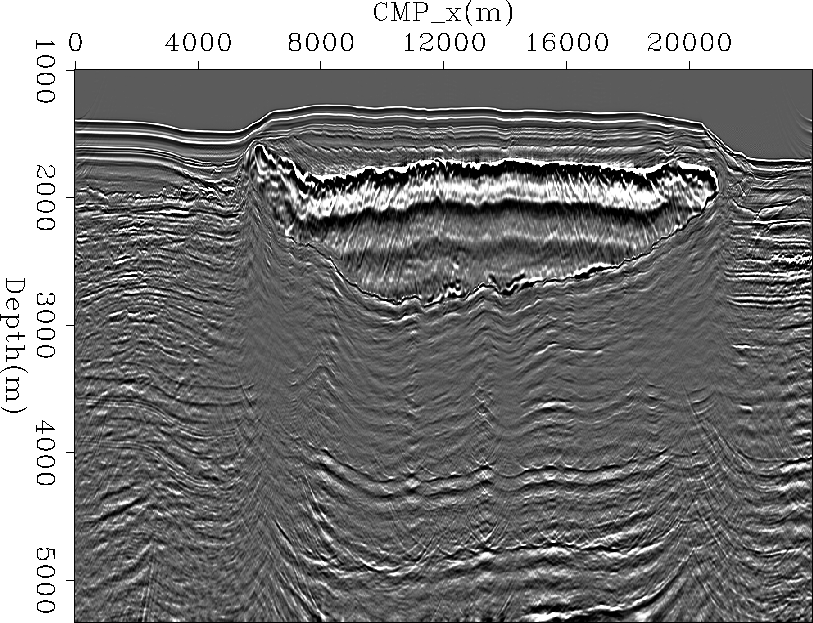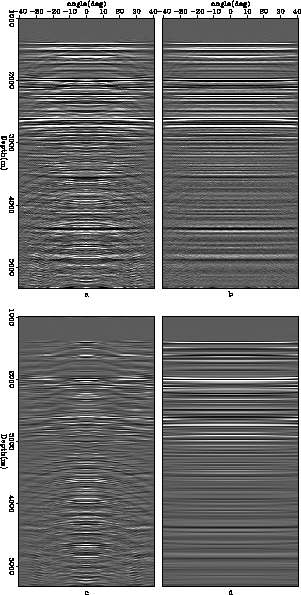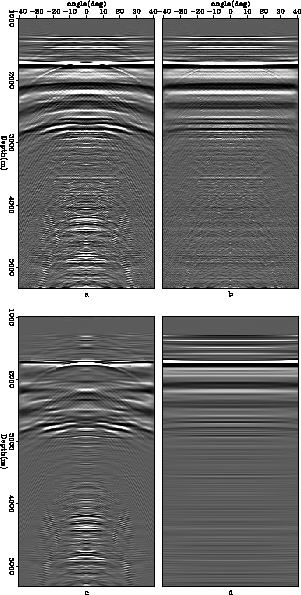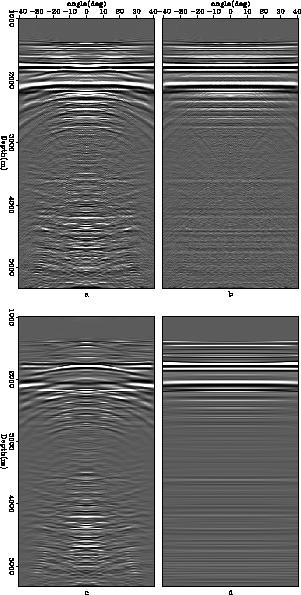 |
Figure 1 Migrated data without multiple attenuation - stacked data. Notice strong migrated multiples, especially below the edges of the salt, corresponding to migrated diffracted multiples.
![[*]](http://sepwww.stanford.edu/latex2html/cross_ref_motif.gif) ,
which corresponds to the stack of ADCIGs without multiple-attenuation, shows complex
patterns of multiples, especially below the edges of the salt, corresponding to diffracted multiples.
Around a depth of 3500 m, the first-order multiple of the sea bottom is probably distorted due
to the alternation between fast and slow velocities. The fitting goal I used to simulate the primaries is the one given in equation (6).
,
which corresponds to the stack of ADCIGs without multiple-attenuation, shows complex
patterns of multiples, especially below the edges of the salt, corresponding to diffracted multiples.
Around a depth of 3500 m, the first-order multiple of the sea bottom is probably distorted due
to the alternation between fast and slow velocities. The fitting goal I used to simulate the primaries is the one given in equation (6).
 |
The results are shown in CIGs near CMP locations 2000, 12000, and 20000 m, in zero-angle sections, and in stacked sections. Figures ![[*]](http://sepwww.stanford.edu/latex2html/cross_ref_motif.gif) ,
, ![[*]](http://sepwww.stanford.edu/latex2html/cross_ref_motif.gif) and
and ![[*]](http://sepwww.stanford.edu/latex2html/cross_ref_motif.gif) illustrate the ADCIGs. In all of the figures are shown in panel (a) the original ADCIG, panel (b) the residual-multiple-attenuated, panel (c) the estimated residual multiples, and panel (d) the simulated primaries. The residual-multiple panels tell us that not only multiples, but every non-flat event in the ADCIG is considered noise to be attenuated (e.g. kinematic effects due to illumination problems and artifacts due to the transformation from subsurface offset to reflection angle). Primaries with significant residual moveout may also be considered events to be attenuated, so it is important to consider the application of residual-moveout correction before the residual-multiple attenuation to preserve the primary information. In this particular case, the velocity model seems to be less accurate for deeper reflectors. The estimated primary panels show significant residual-multiple attenuation, specially at smaller reflection angles.
illustrate the ADCIGs. In all of the figures are shown in panel (a) the original ADCIG, panel (b) the residual-multiple-attenuated, panel (c) the estimated residual multiples, and panel (d) the simulated primaries. The residual-multiple panels tell us that not only multiples, but every non-flat event in the ADCIG is considered noise to be attenuated (e.g. kinematic effects due to illumination problems and artifacts due to the transformation from subsurface offset to reflection angle). Primaries with significant residual moveout may also be considered events to be attenuated, so it is important to consider the application of residual-moveout correction before the residual-multiple attenuation to preserve the primary information. In this particular case, the velocity model seems to be less accurate for deeper reflectors. The estimated primary panels show significant residual-multiple attenuation, specially at smaller reflection angles.
 |
 |
 |
Another issue in methods that rely on the moveout difference between primaries and multiples is the persistence of multiples in the near angles (or offsets) due to insufficient moveout difference between them and the primaries. In sub-salt regions, this problem is especially prominent in ADCIGs because of the poor illumination of larger angles. To guarantee that residual multiples in the near-angle range do not interfere with the computation of the simulated primaries, I applied an internal mute, roughly below depth=3000 m between angles ![]() and
and ![]() . At the CMP location 12000 m; what may seem to be primaries in the near angle are actually residual multiples, as can be clearly seen in the zero-angle section (Figure
. At the CMP location 12000 m; what may seem to be primaries in the near angle are actually residual multiples, as can be clearly seen in the zero-angle section (Figure ![[*]](http://sepwww.stanford.edu/latex2html/cross_ref_motif.gif) ). The zero-angle section of the residual-multiple-attenuated data in Figure
). The zero-angle section of the residual-multiple-attenuated data in Figure ![[*]](http://sepwww.stanford.edu/latex2html/cross_ref_motif.gif) shows that a low-frequency content of the residual multiples remains after the process. Figure
shows that a low-frequency content of the residual multiples remains after the process. Figure ![[*]](http://sepwww.stanford.edu/latex2html/cross_ref_motif.gif) shows details of the zero-angle sections. As can be seen by inspecting the Figures
shows details of the zero-angle sections. As can be seen by inspecting the Figures ![[*]](http://sepwww.stanford.edu/latex2html/cross_ref_motif.gif) a and
a and ![[*]](http://sepwww.stanford.edu/latex2html/cross_ref_motif.gif) b, after the residual-multiple attenuation, some reflectors have been revealed. This final result obtained for the near-angle section has great impact in AVA analysis. Unfortunately, it is very difficult to observe a typical reflector below the edge of the salt body, in the zero-reflection-angle gathers, making it hard to evaluate the efficacy of the method in preserving primaries in such a complex geology. However, as can be observed in Figures
b, after the residual-multiple attenuation, some reflectors have been revealed. This final result obtained for the near-angle section has great impact in AVA analysis. Unfortunately, it is very difficult to observe a typical reflector below the edge of the salt body, in the zero-reflection-angle gathers, making it hard to evaluate the efficacy of the method in preserving primaries in such a complex geology. However, as can be observed in Figures ![[*]](http://sepwww.stanford.edu/latex2html/cross_ref_motif.gif) c and
c and ![[*]](http://sepwww.stanford.edu/latex2html/cross_ref_motif.gif) d, the residual multiples are not as strong as before.
d, the residual multiples are not as strong as before.
Interestingly, below the edges of the salt body where diffracted multiples are more prominent, parts of the residuals of diffracted multiples, which look like migration smiles dipping to the right, remain untouched (e.g. CMP location 20000 m). Conversely, diffracted migrated multiples dipping to the left are well attenuated. By inspecting the corresponding ADCIG, (Figure ![[*]](http://sepwww.stanford.edu/latex2html/cross_ref_motif.gif) ) one can see that the apex of the untouched diffracted multiples (around depth = 3700 m and reflection angles =
) one can see that the apex of the untouched diffracted multiples (around depth = 3700 m and reflection angles = ![]() ) is out of the internal mute (roughly
) is out of the internal mute (roughly ![]() ) applied. Additionally, their tops are relatively flat. Therefore, they give rise to ``false'' simulated primaries and are not attenuated at all.
) applied. Additionally, their tops are relatively flat. Therefore, they give rise to ``false'' simulated primaries and are not attenuated at all.
Disregarding the imperfections which break the assumption of flatness, by comparing the original and the attenuated ADCIGs we can see that the results are promising. Most of the residual-multiple energy has been attenuated.
In spite of the simplicity of the assumptions, the method provides a cleaner image for interpretation, as the comparison of Figures ![[*]](http://sepwww.stanford.edu/latex2html/cross_ref_motif.gif) and
and ![[*]](http://sepwww.stanford.edu/latex2html/cross_ref_motif.gif) shows. A zoomed version is presented in Figure
shows. A zoomed version is presented in Figure ![[*]](http://sepwww.stanford.edu/latex2html/cross_ref_motif.gif) .
.